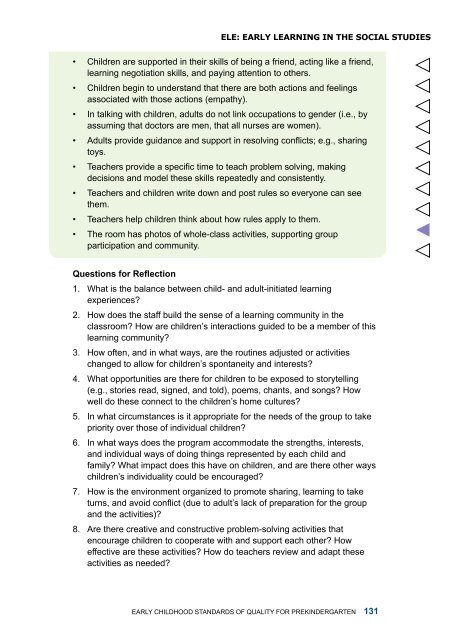Early Childhood Standards of Quality for ... - State of Michigan
Early Childhood Standards of Quality for ... - State of Michigan
Early Childhood Standards of Quality for ... - State of Michigan
Create successful ePaper yourself
Turn your PDF publications into a flip-book with our unique Google optimized e-Paper software.
ELE: EARLY LEARNING IN THE SOCIAL STUDIES• Children are supported in their skills <strong>of</strong> being a friend, acting like a friend,learning negotiation skills, and paying attention to others.• Children begin to understand that there are both actions and feelingsassociated with those actions (empathy).• In talking with children, adults do not link occupations to gender (i.e., byassuming that doctors are men, that all nurses are women).• Adults provide guidance and support in resolving conflicts; e.g., sharingtoys.• Teachers provide a specific time to teach problem solving, makingdecisions and model these skills repeatedly and consistently.• Teachers and children write down and post rules so everyone can seethem.• Teachers help children think about how rules apply to them.• The room has photos <strong>of</strong> whole-class activities, supporting groupparticipation and community.Questions <strong>for</strong> Reflection1. What is the balance between child- and adult-initiated learningexperiences?2. How does the staff build the sense <strong>of</strong> a learning community in theclassroom? How are children’s interactions guided to be a member <strong>of</strong> thislearning community?3. How <strong>of</strong>ten, and in what ways, are the routines adjusted or activitieschanged to allow <strong>for</strong> children’s spontaneity and interests?4. What opportunities are there <strong>for</strong> children to be exposed to storytelling(e.g., stories read, signed, and told), poems, chants, and songs? Howwell do these connect to the children’s home cultures?5. In what circumstances is it appropriate <strong>for</strong> the needs <strong>of</strong> the group to takepriority over those <strong>of</strong> individual children?6. In what ways does the program accommodate the strengths, interests,and individual ways <strong>of</strong> doing things represented by each child andfamily? What impact does this have on children, and are there other wayschildren’s individuality could be encouraged?7. How is the environment organized to promote sharing, learning to taketurns, and avoid conflict (due to adult’s lack <strong>of</strong> preparation <strong>for</strong> the groupand the activities)?8. Are there creative and constructive problem-solving activities thatencourage children to cooperate with and support each other? Howeffective are these activities? How do teachers review and adapt theseactivities as needed?<strong>Early</strong> <strong>Childhood</strong> <strong>Standards</strong> <strong>of</strong> <strong>Quality</strong> <strong>for</strong> Prekindergarten 131


